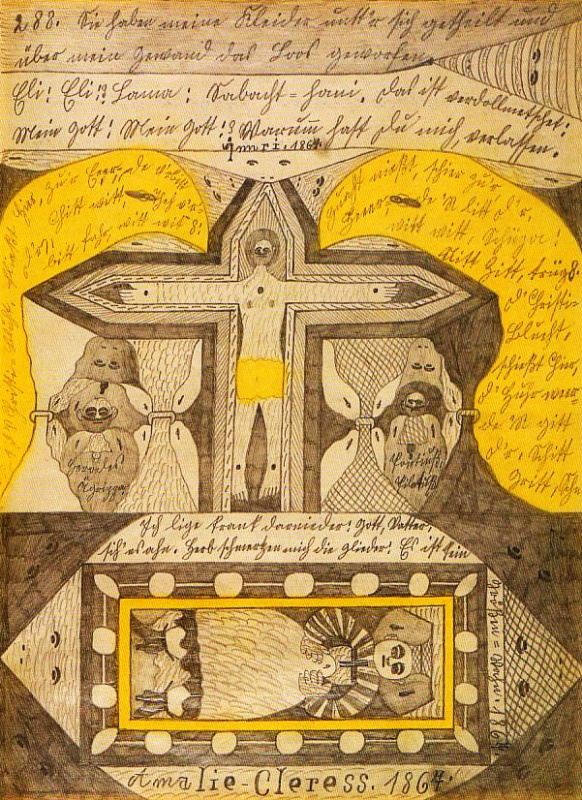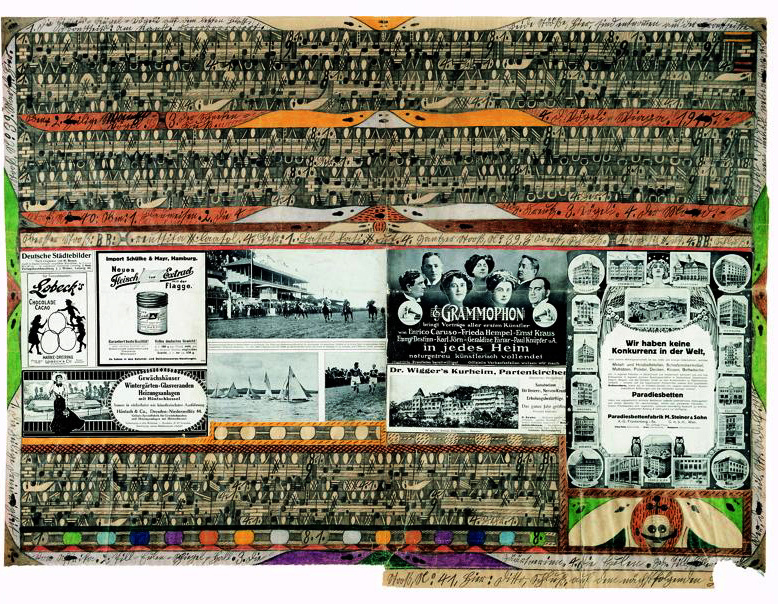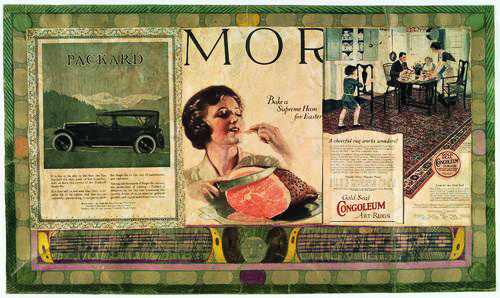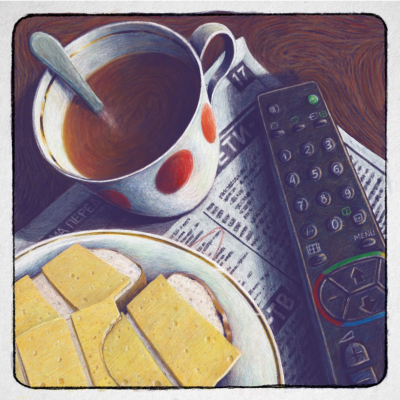Wölfli was a deeply troubled man who managed to harvest the energy that caused him to suffer and turn it into magnificent works of art. He produced all of his work in a mental asylum. Today, he is one of the best-known representatives of the Outsider art.

Understanding the art of the early 20th century is a complex task because there are so many different factors that are all equally important. It was the era of exploration and experimentation and a huge majority of painters and the movements they belong to were trying to find new ways of producing paintings. The great Paul Klee wrote the following words in an article published in 1911:
"The drawings of the mentally disturbed are a parallel phenomenon — thus madness is not an appropriate term of abuse. The truth is that all these paintings should be taken far more seriously than all our art galleries — if it is a matter of reforming the art of today."
These words vividly depict the ideas in the art world during the period when Adolf Wölfli first discovered artistic expression. He approached it as an outsider and yet his life and work would serve as an example for the next few generations of painters.
Dubuffet called him 'le grand Wölfli' and Breton said that Wölfli's body of work was among 'one of the three of four most important works of the twentieth century.'
On the images above:
Amalie-Cleress, 1908; Imperial Eight, 1915; Gramophone, 1915; Saint Mary Castle Giant Grape, 1915; Negro, 1904;
Amalie-Cleress, 1908; Imperial Eight, 1915; Gramophone, 1915; Saint Mary Castle Giant Grape, 1915; Negro, 1904;
Life Before Art
Adolf Wölfli was born on February 29th, 1864 in Bern, Switzerland. His parents were extremely poor and this will heavily influence Adolf’s life, the youngest of their seven children. The family moved around a lot, usually in the pursuit of work. His father Jakob, a stonecutter, was an alcoholic, who showed little to no affection for his family.

The Herdsman/Rose of Australia 1911
Around 1870, Jakob Wölfli left his family. Once separated from their father they lived in dire financial conditions. Adolf’s mother found work as a washerwoman, but her deteriorating health didn’t allow her to work as much as she needed to keep her children well fed.
As just an eight-year-old boy Adolf was separated from his mother and sent to work on a farm. In 1873 Wölfli's mother died. This event has made a profound impact on the emotional life of young Adolf and perhaps set the background for the mental sickness that ailed him for the rest of his life. During this period Alfred was abused on numerous occasions, both physically and mentally.
As just an eight-year-old boy Adolf was separated from his mother and sent to work on a farm. In 1873 Wölfli's mother died. This event has made a profound impact on the emotional life of young Adolf and perhaps set the background for the mental sickness that ailed him for the rest of his life. During this period Alfred was abused on numerous occasions, both physically and mentally.

The Coffin as Monument for Accidents, 1917
For the next decade, he moved from one farm to another doing anything just to survive. He worked in nearly impossible working conditions while experiencing social degradation and humiliation. He couldn’t meet a woman that would marry him, because of his social status and few relationships have been broken by the girl’s parents because he was not suitable for marriage.
Such harsh living conditions gradually weakened Adolf’s mind and at the age of 26 he sexually assaulted two girls aged 14 and 5. He was sent to prison for two years. After being released in 1892, the life he led was even more difficult than before. He spent his time in isolation and poverty.
Such harsh living conditions gradually weakened Adolf’s mind and at the age of 26 he sexually assaulted two girls aged 14 and 5. He was sent to prison for two years. After being released in 1892, the life he led was even more difficult than before. He spent his time in isolation and poverty.

Untitled
Three years after being released from prison, another incident of the same nature took place. This time he was committed to the Waldau Mental Asylum where he was diagnosed with schizophrenia. This event will change Adolf Wölfli's life and in a way, it signifies the beginning of his life as an artist.
Art works in mysterious ways
Wölfli didn’t even know that he had an affinity towards artistic expression until the age of 35. The exact moment when he started drawing is not known, but most of his biographers speculate that it happened somewhere between 1899 and 1906.
Over the next three decades, he will paint, compose music and write a semi-biographical book that has 45 volumes, approximately 25.000 pages, and more than 1.600 illustrations.
Wölfli's artistic output was monitored by his doctor Walter Morgenthaler, who studied and documented his progress from 1907 to 1919. In 1921 Dr. Morgenthaler published a book titled 'A Psychiatric patient as Artist' that was almost entirely based on Adolf’s life in the asylum. The book introduced Wölfli to the art world and it largely contributed to the recognition of Outsider art as meaningful art. In his book Morgenthaler gives us an insight into Adolf’s everyday life in the asylum, and describes how frantically he worked:
'He often writes with pieces only five to seven millimeters long and even with the broken-off points of lead, which he handles deftly, holding them between his fingernails. He carefully collects packing paper and any other paper he can get from the guards and patients in his area; otherwise, he would run out of paper…'
He first started using musical notation on his drawings just a visual symbol or decoration, but through time he started composing musical pieces, some of which can be heard at this link.
Adolf Wölfli died 1930. He was never released from the Waldau Mental Asylum and his work was never shown to the public during his life. It is only after his death that he received recognition for his work.
The forerunner of Art Brut
In order to understand the importance of Adolf Wölfli, we need to understand how important Outsider art was for the Modernist painting. The drawings of children and mentally ill prove that there are different ways to create images. At the time, most of the painters relied on the use of rules of perspective and the education they received in art schools.
The term 'Outsider art' was coined by the Roger Cardinal, an art critic, in 1972 as an English counterpart for the term 'Art Brut' used by Jean Dubuffet. Both terms describe art created on the outskirts of the official culture, particularly children and mentally ill, but 'Outsider art' also includes self-thought artists who create so-called 'naive art'.
On the images above: Cleopatra-St. Adolf-Ring, Giant City in India, 1915; Ferenberg St. Adolf-Stok, 1919; Adolf = Raad = Hall Amazon, 1920; The Holy St. Maria with the Infant Jesus, 1920; Packard, 1927; Kraft Cheese, 1929;
After the II World War, Jean Dubuffet started collecting pieces of art produced by the patients from the psychiatric hospitals. He called this collection 'Art Brut' or Raw art. Many famous artists contributed to the collection, including the inventor of Surrealism Andre Breton.
Wölfli's work was both an example and inspiration to the generation of artists who were looking for ways to move away from established forms and give new meaning to painting and art in general. As Dubuffet said,
"Those works created from solitude and from pure and authentic creative impulses — where the worries of competition, acclaim, and social promotion do not interfere — are, because of these very facts, more precious than the productions of professionals. After a certain familiarity with these flourishings of an exalted feverishness lived so fully and so intensely by their authors, we cannot avoid the feeling that in relation to these works, cultural art in its entirety appears to be the game of a futile society, a fallacious parade."

The legacy of the mad genius
Only a few days before his death Adolf Wölfli complained about not being able to complete the last chapter of his autobiography, as if what he created already wasn’t enough. The urge to create that drove him to create such a huge body of work, allowed him to create a unique visual world that will change how we think about art today. As John McGregor said:
'The alternate world created by Wölfli is one of the most elaborate, strange, and yet thoroughly consistent world pictures ever created by a single individual. In terms of its artistic quality it is also one of the most highly organized and powerful, providing a clear and overwhelmingly impressive view of the workings of the mind in extremis.'

Some forty years after his death, the complete works of Alfred Wölfli were exhibited publicly for the first time. In 1975 Adolf Wölfli Foundation was founded in Bern. It keeps the memory of this great artist alive through publications, group, and one-man exhibitions.
In every century there are artists whose work is so influential that it changes the way the posterity perceives art. Adolf Wölfli was certainly one of them.
Based on: The Reception of Adolf Wölfli's Work 1921 — 1926, Daniel Bauman, 1997
A mental patient as Artist, Walter Morgenthaler, 1921
The Autobiography of St. Adolf II, N. F. Karlins, 2005
Die Alpen, Paul Klee, 1911
Make way for Incivism, Art and Text no.27, Jean Dubuffet, 1987/8
Title illustration: The Atlantic Ocean and the Harbor of Cradle-Beach
Adolf Wölfli, 1911
A mental patient as Artist, Walter Morgenthaler, 1921
The Autobiography of St. Adolf II, N. F. Karlins, 2005
Die Alpen, Paul Klee, 1911
Make way for Incivism, Art and Text no.27, Jean Dubuffet, 1987/8
Title illustration: The Atlantic Ocean and the Harbor of Cradle-Beach
Adolf Wölfli, 1911
























